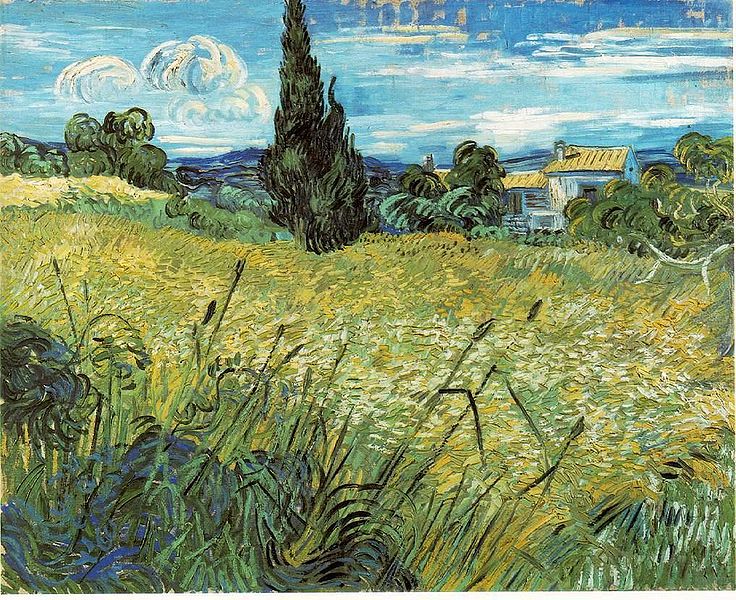THE TECHNIQUE
Leave a commentThe impressionists used innovative techniques to create their paintings. The impressionists were provoked by exciting developments in colour theory. They sacrificed outline and detail to create art that reflected human perception, and aimed for more free form, expressionistic painting (Auricchio, 2000).
Impasto
Impasto is a painting technique that refers to the thick application of paint (usually oil paint). Impasto makes the painting look textured and opaque. When dried, impasto makes the paint look as though it is coming off the canvas (Dunstan, 1983). With the impasto technique, brush strokes are visible. Paint is often laid out on the entire canvas very thickly right from the start of the painting process. Oil paint is most effective in creating the impasto effect because it is thick and dries slowly (Griffel, 1994). Impressionists created the impasto effect by placing a large amount of paint on their brush and painting objects with a series of shorter, uni-directional, brush strokes. The impasto technique eliminates distinctive lines and thereby reflects human perception, rather than an extremely precise depiction of reality (Dunstan, 1983). Furthermore, impasto allows painters to better control the effects of light (impressionists strongly emphasized the effects of light in their paintings), the texture created by impasto gives the painting expressiveness, and the technique can create a three dimensional aspect. Short, thick strokes of paint capture the essence of the object rather than the subject’s details (Encyclopedia Britannica, 2012).
Broken Colour
Broken colour refers to the effect of blending colours optically rather than on the palette. Broken colour eliminates perfect coverage and smoothly-blended transitions. The impressionist painters used layers of colours, and broke up the top layers to reveal the colours underneath (Roveda, 2012). The result of this technique is a lacey coat of paint with gaps in it. The technique is achieved through hatching, cross-hatching, and by making patterned marks that vary in density (Dunstan, 1983). The artist can use dots (referred to as stippling), brushstrokes (referred to as drybrushing), and scratches (known as sgraffito) to create this effect. Hatching refers to painting using layers of short linear brush strokes. If strokes cross, this is called cross-hatching. Hatching allows the artists to better capture the effects of light, and the figure of the object rather than the details (Roveda, 2012). Drybrushing refers to sparsely applying paint with an almost-dry brush; this technique leaves gaps in the paint applied, and thus when it is applied as a top layer it reveals the colour underneath (Griffel, 1994). Sgraffito refers to the scratching of the surface layer of the painting to reveal the layer underneath.

Top layers are broken up and reveal bottom layers; purple layer is broken up to reveal the blue layer underneath
(Wet Canvas, 2004)
This technique is based on the idea that colours can mix optically to create a more vibrant colour, and attempts to capture the actual sensation of light (Roveda, 2012). For example, if take half a sheet of blue paper and half a sheet of yellow paper and spin them quickly, from across the room you will see the equivalent of a green piece of paper. The green that you would see would be more vibrant than if you just held up a green piece of paper and viewed it from across the room. Broken colour is derived from the principle that colours mix optically, and thus allows impressionists to better capture human perception and the effects of light (Griffel, 1994).
Diffusion and Mixing
Diffusion is a technique of impressionism that replaces hard lines in paintings. Paint is applied to the canvas side-by-side and is mixed optically. Diffusion helps emphasize light (Dunstan, 1983). With diffusion, impressionists avoid sharp edges, and instead create soft edges by applying wet paint into the wet paint of another colour that is already on the canvas. The paint is applied in successive strokes in order to create soft edges between different colours (Roveda, 2012). Impressionists avoid the use of black paint, and dark tones are produced by mixing complementary colours. Mixing of paint is done directly on the canvas to aid in creating the broken colour effect. Mixing is avoided for brighter colours in order to enable optical mixing, and is reserved only for darker tones (Dunstan, 1983). Additionally, impressionists do not use the thin paint films and glazes that were popularized by Renaissance artists (Rewald, 1973). The surface of an impressionist painting is opaque.
Wet Paint
Wet paint is placed into wet paint without waiting for previous applications to dry. This results in softer edges and the intertwining of colour (Griffel, 1994). Painting on a wet canvas was important for achieving diffusion and impasto. When the layers of wet paint dried, it created a three dimensional effect (Dunstan, 1983).
Effets De Soir and En Plein Air
Impressionist painters often worked in the evening. This allowed them to replicate the shadowy effects of twilight (Encyclopedia Britannica, 2012). The effects of light are especially visible in the evening- shadows are created and light has more reflective properties. Thus, painting in the evening allowed the impressionists to better focus their attention on these effects. Impressionists do not use black to paint shadows, rather they use blue to depict the reflection of the sky onto surfaces (Dunstan, 1983).
En Plein Air refers to painting outdoors. Painting outdoors was important for impressionists since they emphasized natural light (The National Gallery U.K., 2012). This technique of painting outdoors helped impressionists better depict the effects of light and emphasize the vibrancy of colours.
There were many new tools that emerged in the 19th century that made these techniques possible. The technology of impressionist paintings (the impressionist technique) is largely a result of the development of these tools, which caused Monet to unintentionally stumble upon the technique (Auricchio, 2000). See ‘Tools’ for more information.
Think you’re an expert? Take the quiz!
Take Our Quiz!



